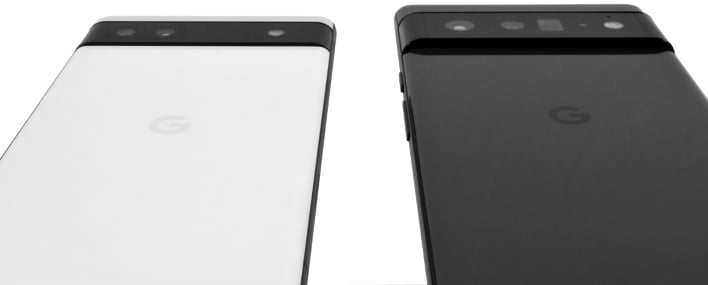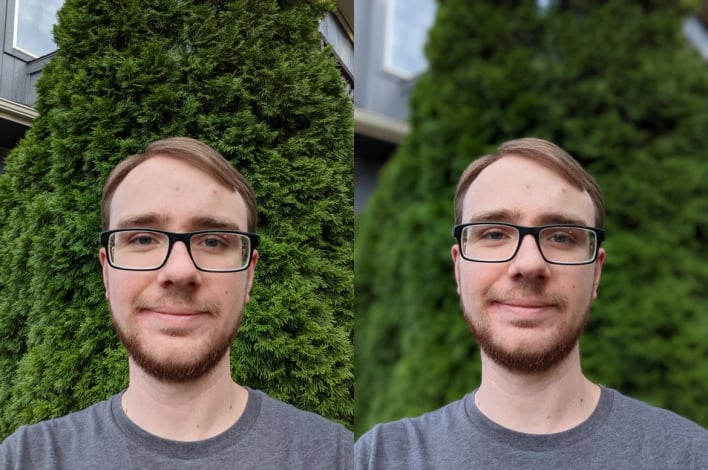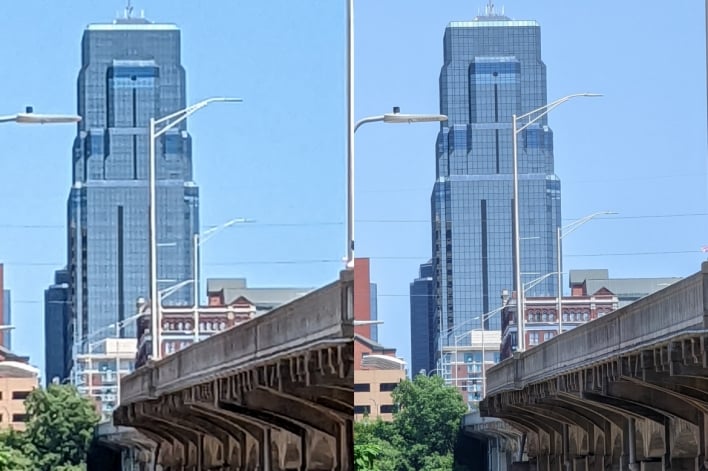Google's Pixel 6a Brings Flagship Features And Performance To A Mainstream Price Point
Google has already given us a sneak peak at the upcoming Pixel 7 series, and we’re looking forward to seeing how the company improves upon its current generation of smartphones. However, before Google launches its next generation phones along with Android 13, the company has one more lesson to teach Android phone makers, and that’s how to make a mid-range budget phone that packs great value for the price.
While the Google Pixel 6a goes on sale today, we’ve had our hands on a review unit for a couple weeks and have been running it through its paces. We’re here to report on how well the 6a manages to deliver the goodness found in the 6 and 6 Pro, but at a more affordable price. Making a good budget smartphone is the art of making compromises, and we’ll have to see whether Google has managed to master that art.
Google Pixel 6a Features And Specs
| SoC |
Google Tensor (Octa-Core CPU, Mali-G78 MP20 GPU, Titan M2 security chip) |
| Display | 6.1" FHD+ (1080x2400, 429ppi) OLED, up to 60Hz |
| Memory |
6GB LPDDR5 |
| Storage |
128GB UFS 3.1 |
| Rear-Facing Cameras |
12.2MP f/1.7 OIS main & 12MP f/2.2 OIS ultra-wide-angle |
| Front-Facing Cameras |
8MP f/2.0 wide-angle, 1080p video at 30 fps |
| Video Recording |
Up to 4K @ 60fps, 1080p slo-mo up to 240fps |
| Battery |
4410 mAh, up to 18W charging |
| Authentication |
Under-display fingerprint sensor |
| OS |
Android 12 |
| Dimensions |
6.0 x 2.8 x 0.35" (152.2 x 71.8 x 8.9 mm) |
| Weight |
6.3 oz (178 grams) |
| Dust/Water Resistance |
IP67 dust & water resistance |
| Connectivity |
802.11ax Wi-Fi 6E, Sub-6GHz & mmWave 5G, Bluetooth 5.2 |
| Colors |
Chalk, Charcoal, Sage |
| Pricing |
Starting at $449 Find It @ Amazon |
While the Pixel 6a’s display may not be the fastest, topping out at 60Hz, it’s still a very nice OLED panel. By default, the screen is set to display colors that are somewhat more vivid than those of the more natural sRGB color space, but, even with the color setting on natural, the colors are quite vibrant. The display also has wide viewing angles, with color shift kicking in only at extreme angles and with almost no dimming. We appreciate the flat display of the Pixel 6a in this respect over the 6 Pro’s curved screen. While the 6 Pro has quite good palm rejection, the edges of the display exhibit color shift and dimming with very little movement.
The Pixel 6a also received an upgraded under-display fingerprint sensor. We complained about the one in the Pixel 6 and 6 Pro being somewhat sluggish, so we’re happy to report that the fingerprint sensor in the 6a is quite fast. However, like all under-display fingerprint sensors, the sensor can sometimes fail to work in direct sunlight, requiring the user to shade the portion of the screen above the fingerprint reader.
The display of the Pixel 6a is protected by Corning Gorilla Glass 3, which isn’t as crack and scratch-resistant as the Gorilla Glass Victus found on the front of the Pixel 6 and both the front and back of the 6 Pro. The Pixel 6a’s frame is made of a textured metal alloy, like the frame of the Pixel 6. However, the back of the 6a is made of a composite that feels somewhat like glass, giving it a premium feel, but isn’t as slippery as the glass backs of the Pixel 6 and 6 Pro.
Even though the Pixel 6a’s chassis is made of lower cost materials than its more expensive siblings, it still feels like a premium device in the hand. We appreciate that the Pixel 6a, between its textured frame and composite back, is significantly grippier than the 6 Pro, which feels so slick that we worry about it slipping out of our hands. We also appreciate that the white composite doesn’t show fingerprints like black glass.What Powers The Google Pixel 6a?
Inside the 6a’s chassis sits Google’s first generation Tensor SoC, which brings together eight CPU cores, ARM’s Mali-G78 MP20 GPU, and Google’s own Titan M2 security chip. The eight cores are evenly divided into big cores and little cores, with the big cores being further sub-divided. The core configuration is as follows: two 2.8GHz ARM Cortex-X1 cores, two 2.25GHz ARM Cortex-A76 cores, and four 1.8GHz ARM Cortex-A55 cores. We’ll have to see how this combination performs in the Pixel 6a, though we don’t expect many surprises, having seen how Google’s Tensor SoC performs in the Pixel 6 and 6 Pro. Benchmarks generally show peak Tensor performance as landing below Qualcomm’s Snapdragon 8 Gen 1 and MediaTek’s Dimensity 9000, but above both chip maker’s prior generation offerings.Google has paired Tensor with 6GB of LPDDR5 RAM and 128GB of UFS 3.1 storage in the Pixel 6a. For comparison, the Pixel 6 comes with 8GB of RAM and up to 265GB of storage, while the 6 Pro packs 12GB of RAM and up to 512GB of storage. None of the Pixel 6 devices have a microSD card slot, so users can’t expand storage capacity, which is somewhat unfortunate in the case of the Pixel 6a, where buyers can’t pay more for more storage. Since the Pixel 6a has less memory than the higher-end Pixel devices, you can expect its multi-tasking ability to be inferior. The Pixel 6a’s 4410 mAh battery is also smaller than the 4614 mAh and 5003 mAh batteries in the Pixel 6 and 6 Pro, respectively. However, the smaller battery doesn’t amount to worse battery life, but rather the opposite, thanks in part to the 60Hz display.
Besides the phone itself, the box includes a USB-C to USB-C power cable, as well as a USB Type A to USB-C converter, but no charging brick. Our review unit also came with Google’s own case for the phone, though buyers will have to purchase the case separately. It’s a bit on the thicker side, but isn’t bulky like an OtterBox. It fits the Pixel 6a snugly and protrudes past the edges of the screen and camera bump to protect them from scratching or cracking.
Pixel 6a Cameras And Camera Performance

As you can see in the image above, the Pixel 6a has just two camera sensors, as it lacks the telephoto shooter found in the Pixel 6 Pro. All three Pixel 6 devices share the same 12MP f/2.2 ultra-wide angle camera with optical image stabilization (OIS), but the Pixel 6a’s primary shooter differs from the 50MP f/1.85 primary shooter in both the Pixel 6 and 6 Pro. The 6a bears a smaller 12.2MP f/1.7 primary camera that thankfully still has OIS. A hole-punch cutout in the display makes room for an 8MP f/2.0 selfie camera, which the Pixel 6a shares with the Pixel 6. This selfie shooter has an 84 degree field of view, which isn’t quite as wide as the 94 degree field of view of the 11.1MP f/2.2 selfie camera in the 6 Pro, but is still adequate.
Particularly in outdoor, sunny settings, the Pixel 6a can pull a bit of color out of bright shades. The blue window frame and doors in the image above don’t look quite as teal as they do in real life or in the comparison shot we took with a OnePlus 7T running the GCam mod. Nonetheless, the Pixel 6a still handles the contrast between the vibrant blue and the shadowed areas well, demonstrating fairly high dynamic range.
Unsurprisingly, given that we’ve tested it before, the ultra-wide camera also produces nice photos with lots of details. Pictures taken with this sensor and lens combo also have very little lens distortion, which isn’t always the case with ultra-wide phone cameras. Google may be doing some post-processing here to remove distortion.
If you’re an avid selfie-taker, the Pixel 6a should suit your needs well. We’re pleased both with the quality of the pictures we took with the front-facing camera and the numerous options provided in the camera app’s settings for fine-tuning images after you take them. The camera app has a dedicated Portrait mode, but you can also edit any photo to apply and adjust the Portrait effect. The software does a pretty good job detecting edges, so it can blur the background, but it doesn’t do this job perfectly.
You can take Portrait mode photos with the rear-facing cameras as well, and the above image demonstrates a case where the software does a good job separating the foreground and the background, as well as a case where it doesn’t quite know how best to isolate the two. Portrait mode does a better job with simpler geometric shapes and situations where the background is farther away from the subject. That second limitation isn’t such a big deal, as Portrait mode can look very unnatural when applied to settings where a larger camera with a wide depth of field wouldn’t naturally blur the background due to the closeness of the subject and background.
Magic Eraser definitely still needs some improvement, but in certain cases it can do a good job at removing objects without making the edit obvious. It struggles filling in the space occupied by objects selected for removal when the background is more complex. We took the Pixel 6a to a car meet, thinking it to be the perfect setting to try out Magic Eraser, until we discovered that the feature is largely clueless when it comes to reconstructing sections of cars obscured by people. At present, Magic Eraser is an occasionally useful feature that otherwise functions as an interesting, but sometimes creepy, party trick. The example above is a bit trippy; so long as you don’t pixel peep, Magic Eraser appears to have flawlessly removed the traffic cone, while leaving behind the cone’s reflection in the puddle..
The Pixel 6a, on the other hand, sometimes tries to compensate for its smaller primary sensor and lack of a telephoto lens by applying fairly heavy post-processing to sharpen images taken with the primary sensor. The phone and the camera app actually do a pretty good job of producing zoomed images that look, on first inspection, like they could have been produced by a larger sensor or a zoom lens. When you compare these images to pictures taken with the Pixel 6 Pro, you’ll start to notice that the Pixel 6a zoom shots include more noise and lack some detail.
Even so, the Pixel 6a can produce some 2x zoom images that look pretty sharp, particularly on the device’s display. However, when you pixel peep you’ll notice the negative effects of the heavy post-processing. As you can see in the image above, the Pixel 6a shot has some ringing artifacts around the edges of the letters, while the letters in the Pixel 6 Pro shot have clean edges. Fortunately, while the artifacts in the Pixel 6a shot are unsightly upon close inspection, they aren’t noticeable unless you zoom in on the photo, as we’ve done here.
When not zoomed in, the Pixel 6a holds its own against the 6 Pro, producing very similar images, despite its smaller sensor. We’d be hard-pressed to tell you which of the two shots in the image above came from which phone.
"Smartphone" - Google News
July 22, 2022 at 12:04AM
https://ift.tt/vZEX9wo
Pixel 6a Review: A Mid-Range Smartphone Win For Google - Hot Hardware
"Smartphone" - Google News
https://ift.tt/OmNnCkH
https://ift.tt/2Pu59SN
Bagikan Berita Ini
























0 Response to "Pixel 6a Review: A Mid-Range Smartphone Win For Google - Hot Hardware"
Post a Comment